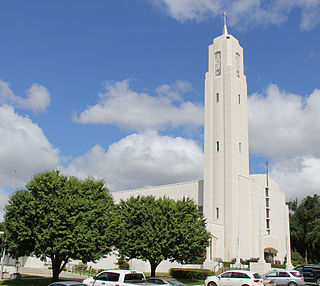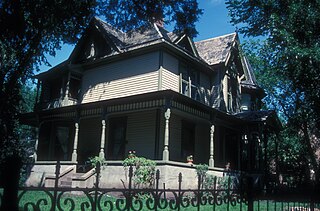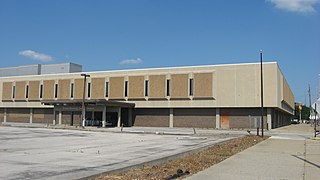
There are 461 properties and historic districts listed on the National Register of Historic Places in North Dakota. There are listings in 52 of North Dakota's 53 counties.

This is a list of the National Register of Historic Places listings in Burleigh County, North Dakota.

This is a list of the National Register of Historic Places listings in Cass County, North Dakota.
The Soo Hotel was later known as the Princess Hotel, The Patterson Hotel Annex, The Hotel Dakotan, Heritage Recovery Center, and Heritage Apartments. It is a historic building located on Fifth Street North in Bismarck, North Dakota, United States, and was listed on the National Register of Historic Places in 1983. It was built by prominent businessman and political powerhouse Edward Patterson in 1906 as a second-class hotel to his other property, the high-class Northwestern Hotel. The four-floor, 76-room hotel was named after the Soo Line Railroad which had arrived in town in 1902 and whose depot was located several blocks away. It was briefly the tallest building in Bismarck.

The Cathedral of the Holy Spirit is a cathedral and parish church of the Catholic Church located in Bismarck, North Dakota, United States. It is the seat of the Diocese of Bismarck. Since 1980 the cathedral and the nearby Bishop's Residence have been contributing properties in the Bismarck Cathedral Area Historic District on the National Register of Historic Places.

Brammer Grocery Store is a historic building located in the West End of Davenport, Iowa, United States. The building was listed on the National Register of Historic Places in 1983. The two-story, brick, Greek Revival style building is an example of a traditional local house form adapted to small-scale commercial use. It features a plain façade, a diamond-shaped light in the gable, and keystones over the second floor windows. John Brammer opened Brammer and Son, a grocery store, in this building in 1885. He joined with Louis Ott in 1895 and they added hardware and paint to their offerings. The store was renamed Brammer and Ott. The building has subsequently housed other business ventures over the years.

Grand Forks Mercantile Company is a property in Grand Forks, North Dakota that was listed on the National Register of Historic Places in 1982. Built in 1893, the building includes Early Commercial and Italianate architecture.

The Fred and Gladys Grady House on East Avenue F in Bismarck, North Dakota was built in 1920. It has also been known as the Grover and Mabel Riggs House. It was listed on the National Register of Historic Places in 2006.
The Oliver and Gertrude Lundquist House on W. Thayer St. in Bismarck, North Dakota was listed on the National Register of Historic Places (NRHP) in 2006. It has also been known as the George and Ada Ebert House.
The James W. Foley House on 6th St. in Bismarck, North Dakota, United States, was built in 1907. It was listed on the National Register of Historic Places (NRHP) in 1977 but was delisted in 1994, when it was relocated to the Missouri Valley Fairgrounds. It has also been known as the Elan Art Gallery.

The Towne–Williams House on 7th St., N., in Bismarck, North Dakota was built in 1885. It has also been known as the George W. Wallace House and as the Erastus A. Williams House. It was listed on the National Register of Historic Places (NRHP) in 1975.

The Chief Looking's Village site (32BL3) is a historic archeological site on the east side of Pioneer Park in Bismarck, North Dakota that was listed on the National Register of Historic Places in 1978. It has also been known as Ward Earth Lodge Village. It was listed on the National Register of Historic Places in 1978.

The Miller Richard and Mary Fisher Tidrick House is a historic residence located in Winterset, Iowa, United States. Miller Tidrick was an Ohio native who settled in Winterset in 1858 and was a member of a well-connected family in town. He served in the 3rd Iowa Volunteer Infantry Regiment during the American Civil War, and married Mary Fisher from the Adel area after being discharged for unknown health reasons in 1862. That same year he established a grocery business in town. In addition to being a businessman, he was involved in several community organizations. This house was built about 1856, and the Tidricks lived here until they moved to a farm in 1882 where he died in 1914.

Jackson Buildings, also known as the Standard Grocery/Capital Furnace, were two historic commercial buildings located at Indianapolis, Indiana. One was a four-story brick building built about 1882–83, and the other, a five-story building built about 1923. The older building exhibited Italianate and Beaux-Arts style design elements. The buildings housed a variety of commercial enterprises, including the Standard Grocery Company. The two buildings were demolished and replaced by a bank building.

The Bowery Street Grocery Store, also known as Helmer's Grocery and as the New Pioneer Food Cooperative, is a historic building located on the east side of Iowa City, Iowa, United States. The building's construction is consistent with those built in the mid-19th century. The single-story wood-frame structure with the false front was a popular commercial style building that was built in Iowa from that time period. Beginning about 1897 the city directory lists this location as a meat market and grocery store. It would continue to house that type of business, under a variety of owners or renters until 1975. The New Pioneer Food Co-op was the last grocery to occupy the space, beginning in 1971, until it relocated to a larger facility. At some point it was illegally converted into student housing, which was not permitted due to the building's small square footage. The building was listed on the National Register of Historic Places in 2014.
The McCone Residence in Glendive in Dawson County, Montana was listed on the National Register of Historic Places in 1988.

The Western Union Building, formerly known as the Hagerty Block and currently as the Dacotah Prairie Museum, is a historic bank building in Aberdeen, South Dakota. It is individually listed on the National Register of Historic Places and is a contributing property to the Aberdeen Commercial Historic District.

The Nathaniel W. Duke House, at 1409 Craig St. in Pueblo, Colorado, was built in 1889. It was listed on the National Register of Historic Places in 1985.
















